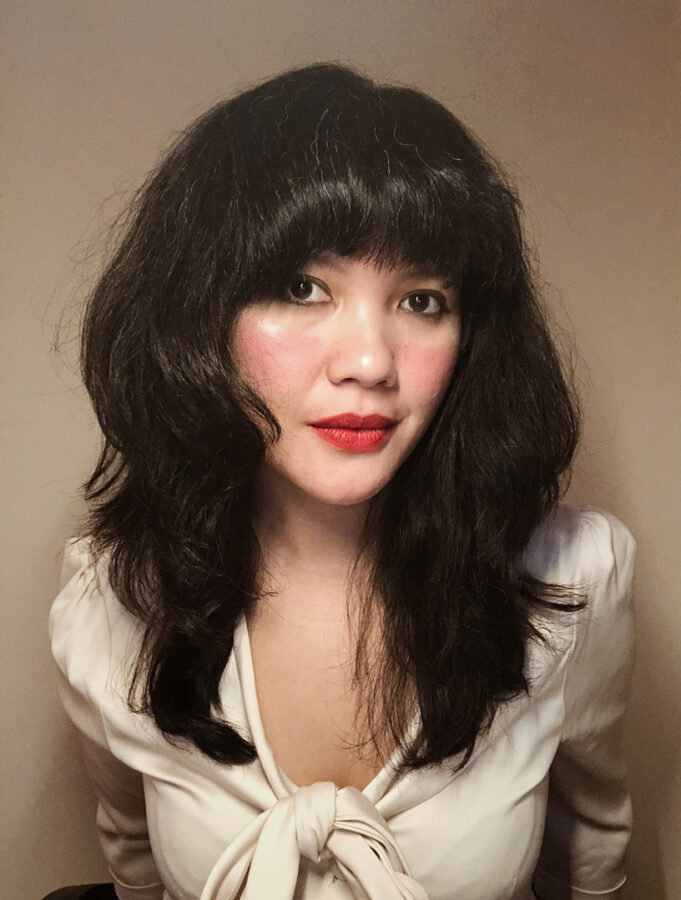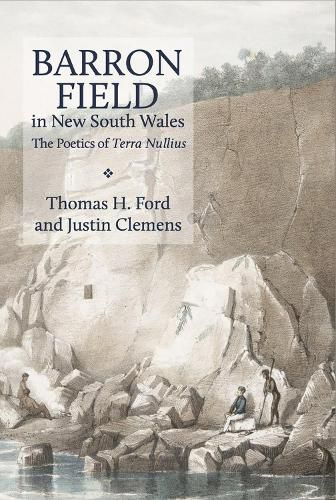Scary Monsters by Michelle de Kretser is a story of travellers: those who are on the move towards something and those who have travelled far and rebuilt their lives. As readers, we, too, are placed as travellers at a crossroads. We see characters arriving and departing, escaping and reinventing. Reading is always an active process, and Scary Monsters invites us to be more conscious of how we read, choose and make meaning. The two front covers of the book promise a mini choose-your-own adventure. Depending on what you choose, the image of a red cherry or the image of a white cherry blossom, you will either read a story grounded in realism with some thriller elements set in early 1980s or a satirical speculative fiction set in the near future.
Where will you go? Will you follow Lili, an Australian young woman of Asian heritage in 1980s France, or Lyle, a middle-aged man who also migrated from Asia in post-pandemic Australia?
Lili moved to Australia when she was fourteen, and she is now a 22-year old teacher working temporarily in Montpellier before postgraduate study at Oxford. She observes Europe’s political developments and contradictions while forging her own path. Lyle, on the other hand, lives in post-pandemic Melbourne, where trees are dying and much of Sydney has disappeared due to bushfires. In this xenophobic not-so distant future, anyone can be repatriated, thus as a migrant Lyle chooses to avoid attention and assimilate fully into what he deems as Australian lifestyle.
How should we interpret Lili’s and Lyle’s seemingly unrelated stories? Should we seek links between them – or view Scary Monsters as two different novellas about migrants? In this novel that prompts readers to make connections and to reflect on disjuncture, Michelle de Kretser returns to the haunting questions of travel that thread through previous work and explores tensions between direction and disorientation, mobility and displacement, as well as the act of claiming and disappearing. She also reminds us that monsters, in various shapes, are lurking in the dark.
The cover with the cherry looked inviting, so I decided to begin with Lili’s story. The starting point quickly brings me to a crossroads; something has passed me by, and now I am watching the characters on the train en route to Sardinia to meet John Berger’s mistress. I had no idea John Berger had a mistress, I thought, and what else have I been missing? It is thrilling to have a sense of direction, however erratic. Lili, the heroine and narrator, is clever and daring, and she befriends Minna, who is similarly bold and has a quirky sense of style. I embrace the prospect of a female-centred adventure and cherish every little moment that disrupts the dominant white male narrative: ‘Napoleon said that to understand a man you had to know what the world looked like when he was twenty. I was twenty-two and Minna was twenty and it was 1981.’
I see my younger self in Lili, a woman of colour who desires to see the world with all her naivete: ‘Simone de Beauvoir was philosophy, Paris, politics, progress. I wanted to be her. I wanted her life. She was Bold, Intelligent Woman.’ Lili wishes to leave her imprint. She looks up to feminist models from de Beauvoir to Debbie Harry the ‘Sexy, Modern Woman’. I am troubled and curious to know why no women of colour inspire her, so I would like to hear her story. After all, how often do we see women of colour as travellers and observers who gaze at the world, not the one being gazed upon? What sort of path will Lili take?
A crossroads can be disorienting. As readers and travellers, we often ask ourselves whether we should make sense of our present moment by looking ahead or looking back. Scary Monsters captures this dilemma very well, and we are drawn to ask not only ‘Where will you go?’ but also ‘Where have you been?’ In different ways, both Lili and Lyle escape the past. They have migrated to Australia from a foreign country that is referred to as ‘Asia,’ the non-specific ‘have been’. We have limited access to this place but we know that the ‘Asia’ that the characters left behind continues to shape their current reality.
Lili, who migrated as a teenager in an era when White-Australia policy had just been dismantled, is still grappling with her identity as an Asian minority. With her travel to Europe, where she is often requested for identification owing to her skin colour, she is twice displaced: ‘I was always asked for ID, but as soon as I showed my passport, I was waved on. Australian were not ang-ter-es-sung’. As a woman of colour with an Australian passport, Lili experiences herself as being in between; Asia is no longer her home, but she has not been in Australia for long. This Lili is ready to leave the past behind: ‘… In those days I believed the past could be left behind like a country’. As our relationship with our past tends to change as we get older, we wonder: What would older Lili think?
The book invites us to imagine. Perhaps our questions about the past will be answered in the future. Is Lyle the future of Lili, or is there a disconnect? The latter option is perhaps more comforting. Meeting Lyle at the crossroads offers a different experience. If Lili’s story in 1981 emanates forward momentum, Lyle’s story is a wearied gaze of the future. Lyle has left his past behind but not with a sense of defiance, as Lili did. In fact, all his actions are about conformity. To integrate into Australian culture, Lyle and his wife have altered their orientation, way of life, and even their names (‘we haven’t always been Chanel and Lyle’). As, Chanel tells her husband, ‘Don’t look back. That’s not the Australian way. It’s a modern country that looks to the future.’
There is not much to see in the future. Ecological damage has wreaked havoc on people’s homes, new diseases keep coming, and everyone fears social contact without masks and hand sanitiser (‘it is rumoured the Next One will be gastrointestinal’). Muslims must change their identities now that Islam is outlawed. The future is morbid, and the story cleverly opens with a recollection of death. Lyle remembers his dog, Alan, who was put to death ‘for his own good’. The story of Alan foreshadows dreadful questions around death and what is ‘good’ that Lyle must face later. In the opening, however, the dog reminds Lyle of his effort to fit into the notion of Australianness. Having a dog is a marker of identity, especially if one avoids being associated with Islam, as Lyle recalls: ‘When Islam was banned and the arrests followed, who knows what difficulties might have come our way if not for Alan?’
Both protagonists in Scary Monsters are privileged with mobility, yet they constantly experience displacement. Privilege here is of course a slippery notion. It signals that some other people do not have the chance to travel, learn French, and study Simone de Beauvoir, like Lili, or migrate to a new country and become obsessed with home improvement, like Lyle. However, Lili and Lyle’s privilege differs significantly from that of the dominant groups. Lili is subjected to subtle prejudice as a result of her skin colour, which she acquired from her grandmother, who migrated to Asia from Armenia. She sees how France honours the struggle for freedom while continuing to mistreat North African immigrants.
The sense of displacement lurks when Lili is with her friends. We get the ‘girls just want to have fun’ picture as Lili and Minna look at fashion magazines, smoke, listen to music, and nibble cakes and chocolates, yet their friendship is haunted by racial and class difference. Lili benefits from her education but lives a thrifty life; in contrast, Minna is white, wealthy, and attractive, drawing attention wherever she goes, and Lili views her with a mix of admiration and jealousy: ‘There was the thought of rich Minna versus poor Lili. There was the thought of white Minna versus brown Lili’. Whiteness signifies mobility. With her access and privilege, Minna glides effortlessly in and out of spaces, performing identities – from hair colour to fashion to politics – as she pleases. At some point we begin to question whether befriending ‘brown Lili’ is also a fashion choice, a way for Minna to portray herself as an open-minded and adventurous woman. When Minna tells Lili, ‘Your skin’s the most beautiful colour,’ Lili recognises another layer of meaning: ‘Minna might as well have said, See? I find dark skin attractive – congratulate me!’
Displacement is both a prospect and a lived reality for Lyle and his family. With the introduction of new migrant policies, there is always the risk of being displaced and returned to the country of origin. Lyle knows very well the consequences of dissent. As an administrative worker at ‘The Department,’ which keeps every record of citizens’ lives, he understands the mechanisms of surveillance and complies with them. Surveillance ensures that neoliberal capitalism is alive and well in a world of environmental ruin, sickness, and bigotry. Lyle and his family keep themselves busy talking about jobs, renovations, and material acquisition to avoid any sentiments or situations of displacement: ‘Household debt and house improvements are fundamental Australian values.’ People in de Kretser’s vision of the future utilise brands as their names, a darker version of today’s fixation with personal branding. Religion has been discarded but people follow consumer culture religiously, including immersion in the self-care industry. Chanel, for example, spends hours on her excessive self-care regime, with several different types of exercise and beauty treatment.
In provoking thoughts around mobility, Scary Monsters asks what it means to appear and disappear in the globalised world. In her book A Decolonial Feminism (2021), Françoise Vergès discusses how institutions in twenty-first-century France could not function without women who clean the floors, toilets, and restaurants and engage in care work – the kinds of work that are both indispensable and invisible, done by racialized migrant subjects. Economies in the Global North are supported by migrants, both legal and undocumented, who have travelled from their home countries and must keep a low profile to avoid any troubles. Lili and Lyle do not live the precarious lives of low-paid migrant workers but they nevertheless oscillate between visibility and invisibility.
Due to intolerant policies, Lyle believes that he cannot afford to be visible. The need to go under the radar informs his choices, including his taste for outfits with natural colours to go to work. His daughter tells him: ‘If you stood next to a filing cabinet, you will be invisible.’ De Kretser provides a nuanced space for different expressions under a policed state; not all family members share Lyle’s fear of being seen and his choice for ‘no brand identity’. His wife and children are concerned with visibility, albeit for different reasons. Ambitious Chanel is focused on maintaining her public persona, in line with her neoliberal ethos, Sydney joins a ‘Green’ community and engages in activism that worries Lyle for being too visible and therefore dangerous, and Mel is embarrassed by her citizenship status abroad due to Australia’s reputation for racism and Islamophobia.
Lili’s story shows a different perspective on visibility, that of a woman of colour who claims her place in a world in motion. Lili has been socialised by her parents not to attract attention: ‘Walking back, I made myself stride. For a long time after arriving in Australia, my instinct had been to creep and pass unnoticed. Servants walk like that in their masters’ house’. Lili is tired of having to hide; she wants to be seen. Her visibility is an intervention in the history that keeps pushing women like her to the side. In the end, Lili asserts, ‘I was Bold, Sexy, Modern, and Intelligent. History would have to sprint to keep up with me’. Lili’s travel story is risky, but it is an empowering one.
The question of in/visibility eventually leads us to the title of the book itself, Scary Monsters, drawn from David Bowie’s 1980 album Scary Monsters (and Super Creeps). As the travellers appear and disappear, we need to figure out: where are the monsters? Are they hiding, or are they creeping among us?
At a crossroads we make decisions and play games. Can you spot the monsters? Lili learns about monsters on the streets. As a young woman, she is curious but worried about her safety. She is afraid that her next-door neighbour is one of those serial killers, like the Yorkshire Ripper, who are waiting for the opportune moment to strike. She also learns about other manifestations of monstrosity, such as prejudice and racialized violence, which coexist with the celebration of European culture and values.
Monsters, too, can be visible and invisible. They live in the master’s house, which, in Lili’s case, is the Western education system that enlightens but elides the questions of race and the ongoing impact of colonialism. Lili studies literature and feminism via de Beauvoir, but she has no women of colour as models because these women have been marginalised from the dominant knowledge production. Monsters erase and exclude. Perhaps older Lili will discover that two years before her journey in France, Audre Lorde had warned us that ‘the master’s tools will never dismantle the master’s house.’
As we are busy observing people passing by at the crossroads, we fail to notice how we are implicated. Lyle’s story compels us to challenge ourselves with difficult questions. To what extent should we shape ourselves to conform, to contribute, to skilfully use the master’s tools? As Lyle tries to focus only on productivity to prove his contribution to the Australian society, he is confronted with the system’s exclusion of non-contributing bodies, including the sick and the elderly. Once old age and sickness dictate that certain bodies are no longer productive, the only thing that matters is the economic potential of inheritances. Looking at his sick mother, Lyle has to decide.
Necropolitics, or what Achille Mbembe describes as the power to decide how some people can live while others must die, characterises how power operates in this neoliberal capitalist future. Of course, this is not a new phenomenon. Scary Monsters allows us to reflect on our present time, in which governments around the world create categories such as ‘criminals,’ ‘terrorists’ or ‘refugees’ to normalise certain deaths. The horror is not just the intolerant state, or surveillance, but the colonised minds. In the time when the political and economic system is supported by invisibility and disposable lives, to what extent should we remain silent and complicit to protect ourselves?
Scary Monsters is an invitation for us to be both readers and travellers. In our journey, we will meet other travellers and listen to their stories. But beware of monsters at a crossroads; they might confront us without warning, or they might blend in the crowd and slowly kills. Better still, keep a mirror at all times. The monsters have most likely been with us all along.







